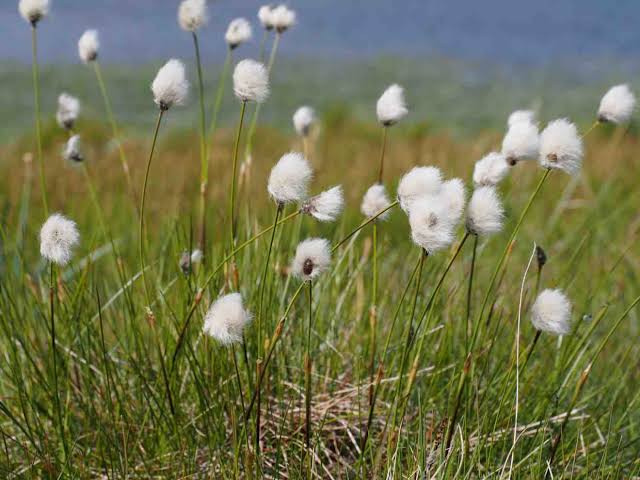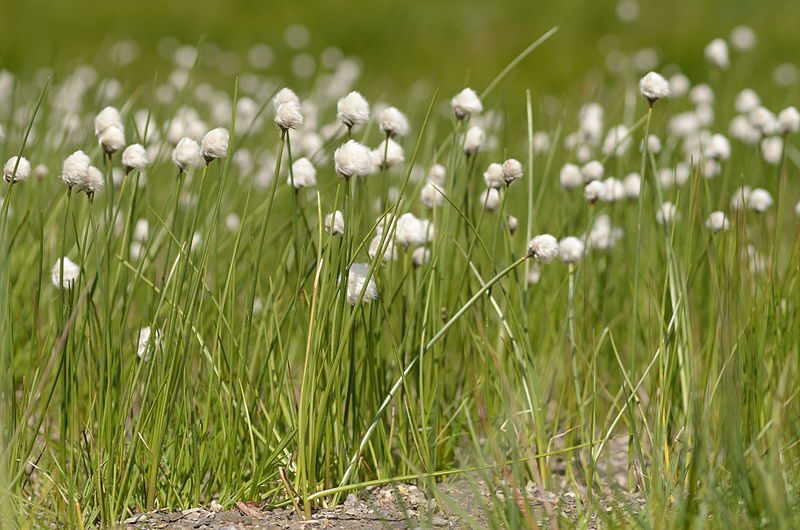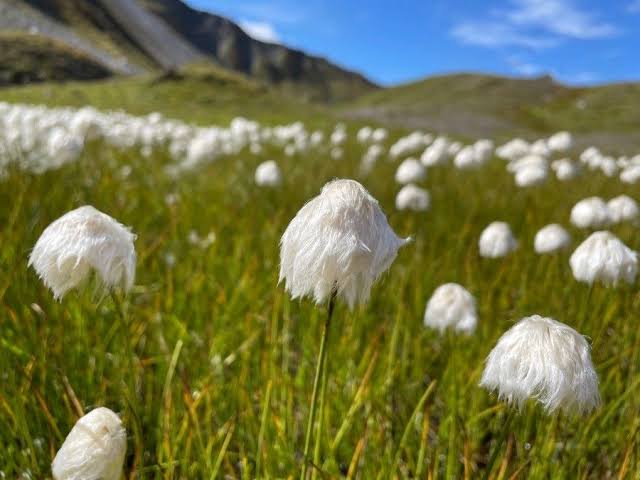White cottongrass (Eriophorum scheuchzeri) is a unique and fascinating plant that can be found in various wetland habitats across the Northern Hemisphere. Its scientific name, Eriophorum scheuchzeri, might sound complex, but the plant itself is quite simple and elegant in appearance.
This remarkable species is often referred to as “cottongrass” due to the fluffy, cotton-like tufts that adorn its flowering heads. These tufts, which are actually composed of fine, hair-like structures, give the plant a distinct appearance, reminiscent of a soft, white cotton ball. The botanical name “Eriophorum scheuchzeri” pays tribute to Johann Jakob Scheuchzer, a Swiss naturalist who made significant contributions to the study of botany in the 18th century.
White cottongrass is typically found in wet and boggy areas, where its specialized adaptations allow it to thrive. The plant has slender, grass-like leaves that rise from the base, providing support for its characteristic flowering stems. The flowering heads emerge in late spring to early summer, creating a striking visual display in wetland ecosystems.
Despite its cotton-like appearance, the fluffy tufts are not seeds but rather aid in seed dispersal. The seeds are small and lightweight, allowing them to be carried by the wind to new locations, facilitating the plant’s colonization of diverse habitats. This dispersal strategy is crucial for the survival and expansion of white cottongrass populations.
Beyond its aesthetic appeal, white cottongrass plays a vital ecological role in wetland ecosystems. It contributes to the overall biodiversity by providing habitat and food sources for various organisms. In addition, the plant’s extensive root system helps stabilize the soil in wetland areas, preventing erosion and maintaining the health of these fragile ecosystems.
White cottongrass has also been of interest to traditional communities for its practical uses. Historically, indigenous peoples have utilized different parts of the plant for various purposes. For instance, the tough leaves were woven into mats or baskets, showcasing the plant’s versatility in traditional craftsmanship.
In addition, White cottongrass (Eriophorum scheuchzeri) is a captivating plant with a simple yet elegant presence. Its cotton-like tufts add a touch of beauty to wetland landscapes, while its ecological contributions make it an integral part of these delicate ecosystems. Whether admired for its aesthetics or appreciated for its ecological importance, white cottongrass continues to be a subject of fascination and admiration in the natural world.
Read Also: Guide on How to Start Factory Farming
How To Grow White Cottongrass (Eriophorum scheuchzeri)

Growing White cottongrass (Eriophorum scheuchzeri) can be a rewarding experience, especially for those interested in fostering wetland habitats or creating a unique garden setting. Here’s a simple guide on how to grow this distinctive plant:
1. Choose the Right Location: White cottongrass thrives in wet and boggy conditions. Select a location in your garden that mimics these natural habitats. Ensure the soil is consistently moist, with good drainage to prevent waterlogging.
2. Soil Preparation: Prepare the soil by adding organic matter, such as well-rotted compost or peat moss. This helps improve water retention and provides essential nutrients for the plant’s growth.
3. Planting: White cottongrass can be propagated from seeds. Plant the seeds in early spring or fall, covering them lightly with soil. Press the soil down gently to ensure good seed-to-soil contact. Keep the soil consistently moist during the germination period.
4. Watering: Maintain a consistently moist soil throughout the growing season. Regular watering is crucial, especially during dry periods. Avoid overwatering, as this can lead to waterlogged conditions.
5. Sunlight: White cottongrass typically prefers full sun to partial shade. Ensure the plant receives adequate sunlight for healthy growth. However, it can tolerate some shade, making it adaptable to various garden conditions.
6. Maintenance: Once established, White cottongrass is relatively low-maintenance. Mulching around the plants helps retain soil moisture and suppress weeds. However, be cautious not to cover the plant crowns.
7. Wildlife Considerations: If you’re cultivating White cottongrass to attract wildlife, avoid using pesticides or herbicides, as these can harm the plant and the ecosystem it supports. Embrace the natural biodiversity the plant attracts.
8. Enjoying the Fluffy Blooms: Be patient as your White cottongrass grows. The fluffy blooms will emerge in late spring to early summer, providing a delightful display. Take time to appreciate the unique beauty of the plant.
9. Conservation Awareness: If you are growing White cottongrass with conservation in mind, consider local regulations and ethical guidelines. Some regions may have restrictions on collecting seeds from the wild, so it’s essential to be aware of and respect these rules.
10. Observing Local Climate: Keep in mind the local climate conditions. While White cottongrass is hardy in many regions, understanding the specific needs of the plant in your area will contribute to its successful growth.
By following these simple steps, you can cultivate White cottongrass and contribute to the beauty and ecological value of your garden or a wetland restoration project.
How To Care For White Cottongrass (Eriophorum scheuchzeri)
Caring for White cottongrass (Eriophorum scheuchzeri) involves providing the right conditions to support its growth and maintaining its well-being. Here are some essential care tips:
1. Watering: Ensure that the soil remains consistently moist, as White cottongrass naturally thrives in wetland environments. Regular watering, especially during dry periods, is crucial for its health. Avoid waterlogging, as it can lead to root rot.
2. Soil Conditions: White cottongrass prefers acidic, sandy, or peaty soils. Add organic matter like compost or peat moss to improve soil structure and moisture retention. Perform periodic soil tests to monitor pH levels and adjust as needed.
3. Sunlight: Provide the plant with full sun to partial shade. While it can tolerate some shade, it generally thrives in sunlight. Adequate sunlight contributes to healthy growth and the development of its characteristic fluffy blooms.
4. Mulching: Apply a layer of organic mulch around the base of the plant to help retain soil moisture, suppress weeds, and maintain a stable soil temperature. Avoid covering the central crowns of the plant.
5. Pruning: White cottongrass typically doesn’t require extensive pruning. Remove any dead or damaged foliage to promote a tidy appearance. Allow the fluffy blooms to mature and disperse seeds, contributing to the plant’s natural life cycle.
6. Wildlife Considerations: White cottongrass attracts various wildlife, including insects and birds. Embrace this biodiversity and avoid using pesticides or herbicides that can harm beneficial organisms. Creating a wildlife-friendly environment can enhance the overall health of your garden.
7. Fertilization: White cottongrass generally doesn’t require heavy fertilization. If your soil lacks nutrients, consider using a balanced, slow-release fertilizer in spring. However, avoid excessive fertilization, as this may lead to leggy growth.
8. Monitoring Diseases: Keep an eye out for signs of diseases, such as fungal infections. Ensure proper air circulation around the plants and avoid overcrowding to reduce the risk of diseases. If necessary, treat with appropriate fungicides according to the instructions.
9. Conservation Awareness: If you are cultivating White cottongrass with conservation goals, be mindful of local regulations. Respect ethical guidelines and avoid disturbing natural populations. Focus on creating a sustainable and supportive environment for the plant.
10. Winter Preparations: In regions with cold winters, White cottongrass is adapted to withstand freezing temperatures. However, adding a layer of mulch around the base can provide extra insulation and protect the plant during harsh winter conditions.
By attending to these care considerations, you can ensure the well-being of White cottongrass and enjoy its unique beauty in your garden or wetland habitat.
Read Also: The Benefits of Crop Dusting
The Uses of White Cottongrass (Eriophorum scheuchzeri)

White cottongrass (Eriophorum scheuchzeri) has been historically used by various communities for practical purposes. Here are some of the traditional uses of White cottongrass:
1. Traditional Crafts: Indigenous peoples have utilized the tough leaves of White cottongrass for weaving. The leaves were woven into mats, baskets, and other items, showcasing the plant’s versatility in traditional craftsmanship.
2. Insulation Material: The fluffy, cotton-like tufts of White cottongrass have been employed as insulation material in some cultures. These soft fibers can be used to fill pillows, blankets, or even clothing, providing natural insulation properties.
3. Medicinal Purposes: While not a prominent medicinal plant, some traditional cultures have explored potential medicinal uses for White cottongrass. This may include using parts of the plant in poultices or infusions for certain ailments.
4. Wildlife Habitat: White cottongrass plays a significant role in supporting biodiversity by providing habitat and food sources for various wildlife. Birds, insects, and small mammals often use the plant for nesting and foraging.
5. Environmental Restoration: Due to its ability to stabilize soil in wetland areas, White cottongrass is sometimes used in environmental restoration projects. Planting this species can help prevent soil erosion and contribute to the overall health of wetland ecosystems.
6. Educational Purposes: White cottongrass is often used in educational settings to teach students about wetland ecosystems, plant adaptations, and biodiversity. Its unique appearance and ecological importance make it a valuable tool for environmental education.
7. Aesthetic and Ornamental Purposes: Beyond its practical uses, White cottongrass is also cultivated for its aesthetic appeal. Gardeners may plant it for its unique, cotton-like blooms, adding a touch of beauty to gardens and landscapes.
It’s important to note that while White cottongrass has these traditional uses, modern practices often prioritize conservation and sustainable harvesting. Before considering any utilization of the plant, it’s crucial to be aware of local regulations, ethical guidelines, and conservation efforts to ensure the responsible management of this unique species.
Frequently Asked Questions (FAQs)
Q: What is White cottongrass (Eriophorum scheuchzeri)?
A: White cottongrass, scientifically known as Eriophorum scheuchzeri, is a plant found in wetland habitats across the Northern Hemisphere. It is characterized by its grass-like leaves and distinctive fluffy, cotton-like tufts that appear during its flowering stage.
Q: How do I grow White cottongrass in my garden?
A: To grow White cottongrass, choose a wet and boggy location, prepare the soil with organic matter, plant the seeds in early spring or fall, and ensure consistent moisture. Provide full sun to partial shade, mulch around the plant, and be patient as the fluffy blooms emerge.
Q: Can White cottongrass be grown in containers?
A: While White cottongrass naturally thrives in wetland conditions, it may be challenging to replicate these conditions in containers. The plant’s extensive root system and moisture requirements make it better suited for open garden spaces.
Q: How do I care for White cottongrass?
A: Care for White cottongrass by maintaining consistently moist soil, providing full sun to partial shade, mulching to retain moisture, and avoiding waterlogging. Prune dead or damaged foliage, embrace wildlife interactions, and be mindful of local regulations if cultivating for conservation purposes.
Q: Can White cottongrass be used for landscaping?
A: Yes, White cottongrass can be used for landscaping to add a unique and natural touch to gardens. Its cotton-like blooms provide aesthetic appeal, and its ecological contributions make it valuable for creating sustainable and biodiverse landscapes.
Q: Is White cottongrass invasive?
A: White cottongrass is not typically considered invasive. However, when introducing any plant into a new environment, it’s important to monitor its growth and interactions with the local ecosystem to prevent unintended consequences.
Q: What is the best time to plant White cottongrass seeds?
A: The best time to plant White cottongrass seeds is in early spring or fall. This allows the seeds to germinate and establish before the growing season, ensuring a better chance of successful growth.
Q: Can White cottongrass be used for erosion control?
A: Yes, White cottongrass can be beneficial for erosion control, especially in wetland areas. Its extensive root system helps stabilize soil, preventing erosion and contributing to the overall health of wetland ecosystems.
Q: Does White cottongrass have any cultural significance?
A: White cottongrass has cultural significance in some indigenous communities where it has been traditionally used for crafting, including weaving mats and baskets. Its presence in certain ecosystems may also hold symbolic or spiritual value in some cultures.
Q: Is White cottongrass a protected species?
A: White cottongrass may be protected in certain regions, and regulations regarding its cultivation or harvesting can vary. It’s important to check local conservation laws and guidelines before engaging in any activities related to White cottongrass.
Read Also: The Impact of Waste to Compost Business

